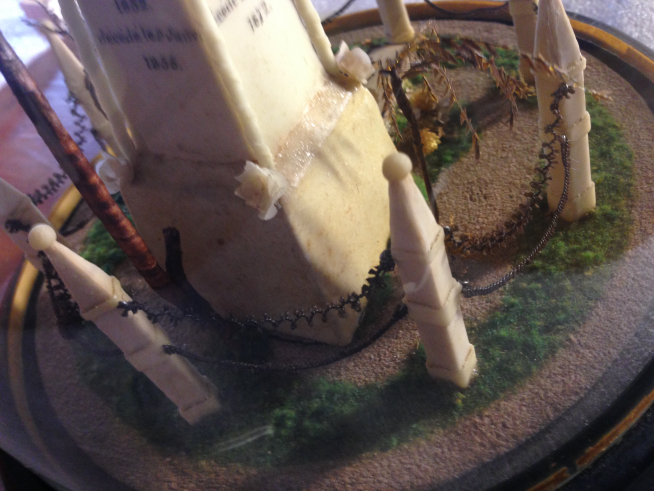CANADA 150 - Quebec - Hair Memorial

The object I want to share today is a small diorama, about 30 centimeters high and 15 centimeters in diameter. It is encased in a glass dome, on a wooden base. The scene is a gravesite, showing an obelisk, a casket marked with a cross, and several trees. The largest tree looks like a model of a weeping willow, with long tendrils of leaves draping over the obelisk. The two smaller trees have diamond shaped leaves, with similar long tendrils. There are small flowers decorating the obelisk, encircling the casket, and seemingly planted in two small plots beside the casket. Brown coloured fabric provides a ground for most of the diorama, and a green coloured felt seems to mimic grass. The obelisk and casket are surrounded by eight fenceposts. The obelisk, casket and fence posts are all the same colour and likely made out of the same material. So far, my research suggests it was likely made of wood with wax modelling. The tree leaves on the large tree, and the links between the eight fence posts that encircle the scene are made of small loops of hair. Two small wreaths of the hair chains are in the scene as well: one lying on the casket, and one sits atop the tall obelisk.

Looking more closely, the gravestone is inscribed with the names of four people, all children.
Evelina Bourdou
January 19, 1870 – September 18, 1878
Napoleon Bourdou
March 31, 1863 – August 18, 1872
Joseph Azarie Bourdou
June 29, 1854 – June 30, 1854
Joseph Bourdou
November 14, 1852 – January 9, 1855
So far, I have found record of this family that indicates as of the 1871 Census of Canada, Louise Bourdou lived in Boucherville, Quebec with her husband Joseph, who was 46. He is listed as a “commercant,” or trader, in English. Louise is 38. This couple have ten children at home with them, Melina (20), Marie (15), Eliza (13), Joseph (11), Louis (9), Napoleon (8), Alice (6), Thomas (4), Ellidia (2), and Evelina (1). The family speaks French at home, and Marie, Eliza, Joseph, Louis, Napoleon and Alice go to school. There are other larger families on the same street, according to the census; it is easy to imagine a neighbourhood overrun with children.
This diorama is a rare example of Victorian era dome craft, and an example of memorial hairwork. Both crafts were fairly common in the late 1800s, but the union of the two in a piece like this is rare. Domes were more often made with purely decorative floral sculptures, and hairwork was more often done to create jewellery. My research into the piece is ongoing, but it is likely that it was made by Louise Bourdou, sometime after the death of Evelina, in memory of her four deceased children.

This is a sad object. This dome was likely made by a mother in mourning, as a way to memorialize her children. Various researchers who have studied hairwork have articulated that hairworks are a particularly important body of decorative arts, since they highlight the intricate nature of women’s emotional lives. For me, the memorials that I have seen so far reflect a quiet endurance that is quite profound. Objects like this dome were not made for profit or acclaim. They were made to heal, to reflect and to memorialize. They are examples of the importance of craft making in human lives.
I share this, close to Canada Day, because sometimes on big anniversaries, it is worthwhile to remember the quieter moments and the moments of endurance through challenges that we all face. In this big collective anniversary time, I want to remember the work, hardship, bravery and strength of everyday people who have lived on this land together for well over 150 years, like the Bourdous.
